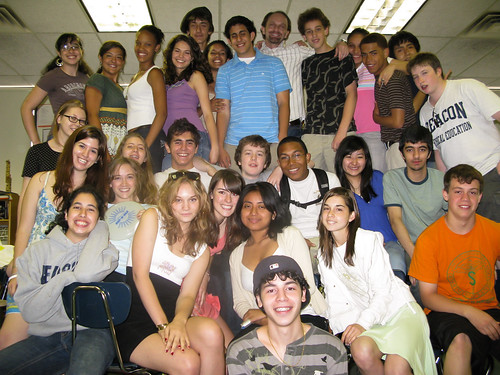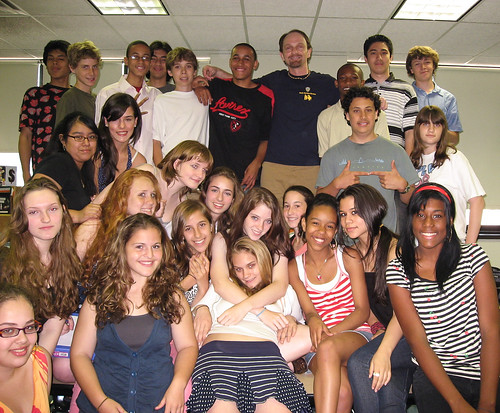1. Waiting for Godot–Read up to p. 77
2. PBA–Continue to gather evidence! Also, as you gather evidence, think about possible arguments for your thesis.
English with Mr. Leon
1. Waiting for Godot–Read up to p. 77
2. PBA–Continue to gather evidence! Also, as you gather evidence, think about possible arguments for your thesis.
1. Waiting for Godot–Complete Act I.
2. PBA–Please be aware of the first due date: May 31st! EVIDENCE!
1. Waiting for Godot–Read and annotate through p. 47. This reading is Lucky’s monologue (equally famous and frustrating). Beckett has stated that the threads and themes of the play are being gathered together in the monologue. Don’t write about it…just think about it…–Analyze Lucky’s monologue in search of meaning…yes, you must weed through the nonsense to pick out the substantial… Although, I would argue that even that which is nonsensical is substantial. There is method to the madness that seemingly is his speech. So, really, what is it that he is saying? Think, human condition. Also, consider how the subject of his speech parallels the plight of Vladimir and Estragon.
Some tips:
2. PBA–Read the thesis statement handout!
1. Waiting for Godot–Read and annotate through p. 44 (stop at Lucky’s monologue)
1. Waiting for Godot–First off, great job today! Read and annotate up to the bottom of p. 15. One final time (last text and all), I challenge you to approach this text with maturity and a keen literary eye in search of thematic understanding…Pay attention to the little things…You will have to read quite closely to discern any meaning…THIS WILL BE YOUR GREATEST CHALLENGE OF THE YEAR! 🙂
2. PBA Prep–You should choose your two texts for this comparative essay. What is the frame of reference? What are the grounds for comparison? (Remember, the grounds for comparison would be the similarities/differences you see in the author’s treatment of your frame of reference.
I let go. Lost in oblivion. Dark and silent and complete. I found freedom. Losing all hope was freedom.

2016-17, English 10B

2016-17, Existentialism

2016-17, Poetry Seminar

2016-17, English 10H

2015-16, Poetry Seminar

2015-16, Existentialism

2015-16, English 10A

2015-16, Poetry Seminar

2015-16, Existentialism

2015-16, English 10C

2010-11, Existential Literature

2010-11, Existential Literature

2014-15, Existential Literature

2014-15, Existential Literature

2014-15, English 10E

2014-15, English 10H

2014-15, Poetry Seminar

2013-14, Existential Literature

2013-14, English 10H

2013-14, Existential Literature

2013-14, Beacon 10th

2012-13, Beacon 10th

2011-12, Beacon 12th

2011-12, Beacon 10th

2011-12, Beacon 12th

2011-12, Beacon 10th

2005-06, Bronx Writing Academy

2004-05, Bronx Writing Academy

2002-03, Jordan L. Mott

2008-09, Beacon 9th

2008-09, Beacon 10th

2008-09, Beacon 9th

2010-11, Beacon 10th

2010-11, Beacon 12th

2010-11, Beacon 10th

2010-11, Beacon 12th

2007-08, Beacon 9th

2007-08, Beacon 10th

2007-08, Beacon 10th

2006-07, Beacon 10th

2006-07, Beacon 9th

2006-07, Beacon 9th

2010-11, Beacon 12th

2009-10, Beacon 10th

2009-10, Beacon 10th

2009-10, Beacon 12th

2003-04, Jordan L. Mott
1984 Announcement Art as Social Commentary Beat Poetry Class Forum Confessional Poem Detailed Outline Exemplar Existentialism is a Humanism Goodreads Imagism Insight Paper In the Time of Butterflies Letters to a Young Poet Man's Search for Meaning Mandala Nausea No Exit PBA: English 10 PBA: Existentialism PBA: Poetry Seminar Pics Poetry Precis Romanticism Satire/Parody Project Schopenhauer Siddhartha Slaughterhouse Five Steppenwolf Student Art Student Poetry Term Final The Alchemist The Bell Jar The Death of Ivan Ilyich The Encounter with Nothingness Thesis The Stranger The Trial Villanelle Vocabulary Waiting for Godot Where are You Going Writing Workshop
| M | T | W | T | F | S | S |
|---|---|---|---|---|---|---|
| 1 | 2 | 3 | 4 | 5 | ||
| 6 | 7 | 8 | 9 | 10 | 11 | 12 |
| 13 | 14 | 15 | 16 | 17 | 18 | 19 |
| 20 | 21 | 22 | 23 | 24 | 25 | 26 |
| 27 | 28 | 29 | 30 | 31 | ||
Copyright © 2024 Blackboard Dreams and Sean Leon · All Rights Reserved · Log in